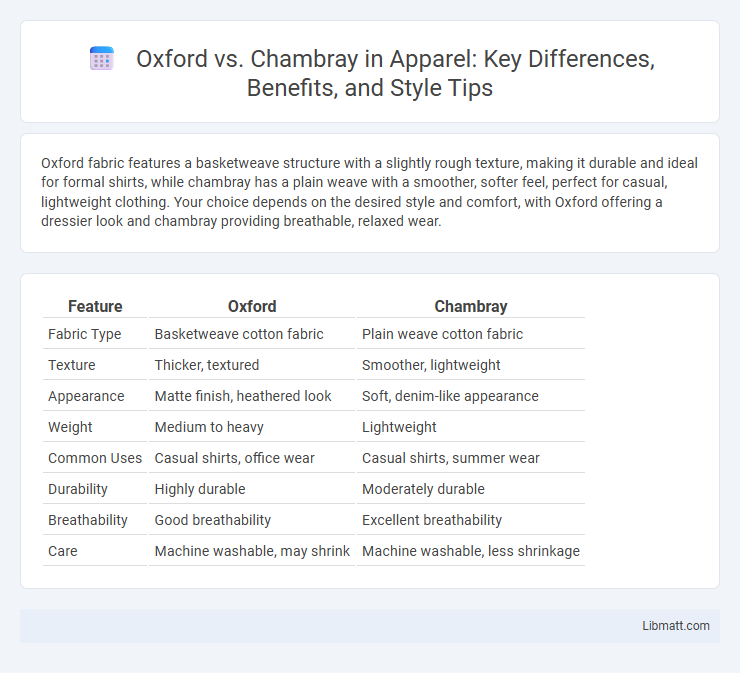Oxford fabric features a basketweave structure with a slightly rough texture, making it durable and ideal for formal shirts, while chambray has a plain weave with a smoother, softer feel, perfect for casual, lightweight clothing. Your choice depends on the desired style and comfort, with Oxford offering a dressier look and chambray providing breathable, relaxed wear.
Table of Comparison
| Feature | Oxford | Chambray |
|---|---|---|
| Fabric Type | Basketweave cotton fabric | Plain weave cotton fabric |
| Texture | Thicker, textured | Smoother, lightweight |
| Appearance | Matte finish, heathered look | Soft, denim-like appearance |
| Weight | Medium to heavy | Lightweight |
| Common Uses | Casual shirts, office wear | Casual shirts, summer wear |
| Durability | Highly durable | Moderately durable |
| Breathability | Good breathability | Excellent breathability |
| Care | Machine washable, may shrink | Machine washable, less shrinkage |
Introduction to Oxford and Chambray Fabrics
Oxford fabric is a type of woven cotton known for its basketweave structure, offering durability and a slightly textured appearance ideal for dress shirts. Chambray fabric features a plain weave with a colored warp and a white weft, producing a lightweight, breathable textile often used for casual shirts. Both fabrics are popular in menswear but differ significantly in texture, weight, and formality.
Historical Background of Oxford and Chambray
Oxford fabric originated in Scotland in the late 19th century, becoming a staple for traditional men's shirts due to its basketweave structure and durability. Chambray has roots dating back to the French town of Cambrai, where it was first woven in the 17th century as a lightweight, plain-weave cotton fabric. Your choice between Oxford and chambray will reflect a balance between the heritage and texture each fabric brings to modern apparel.
Fabric Weave and Construction Differences
Oxford fabric features a basketweave construction with multiple yarns woven together, resulting in a thicker, more textured feel ideal for durability and casual wear. Chambray uses a plain weave with a colored warp and white weft, creating a lightweight, smooth fabric that mimics denim's appearance but remains breathable and soft. Understanding these fabric weave and construction differences helps you choose between Oxford's robust texture and chambray's crisp comfort for your shirts.
Texture and Appearance Comparison
Oxford fabric features a basketweave texture that creates a slightly rough, durable surface with subtle visual depth, often characterized by a casual yet polished look. Chambray offers a smoother, softer texture with a plain weave that produces a lightweight, airy appearance, commonly displaying a heathered or two-tone color effect. Your choice between Oxford and chambray will influence both the tactile feel and the aesthetic of your garments, with Oxford leaning toward structured durability and chambray favoring softness and breathability.
Comfort and Breathability Factors
Oxford fabric features a basketweave structure that offers durable breathability, making it ideal for garments requiring moderate airflow and softness. Chambray, woven with a plain weave using finer yarns, provides a lighter, more breathable texture, enhancing comfort in warmer climates. Both fabrics balance comfort and breathability, with chambray typically delivering a lighter, airier feel suitable for warmer conditions.
Durability and Longevity
Oxford fabric is known for its exceptional durability due to its basketweave structure, which offers increased resistance to wear and tear, making it ideal for long-lasting shirts. Chambray, while lightweight and breathable, tends to be less durable over time because it uses a plain weave that is more prone to fraying and fading. You will find Oxford shirts retain their strength and appearance much longer, making them a better investment for lasting wardrobe staples.
Versatility in Styling
Oxford fabric offers a more structured and classic appearance, making it perfect for both casual and business-casual looks, while chambray provides a softer, lighter texture ideal for relaxed, warm-weather outfits. Your wardrobe benefits from Oxford's ability to pair seamlessly with blazers and chinos, whereas chambray excels as a standalone piece or layered with casual jackets. Both fabrics enhance versatility, but knowing when to choose each depends on the desired level of formality and comfort.
Formality and Dress Codes
Oxford fabric offers a slightly more formal appearance with a textured weave that pairs well with business casual and smart casual dress codes, making it suitable for office settings and semi-formal events. Chambray, characterized by its plain weave and lightweight feel, is more casual and often favored in relaxed environments or casual Friday attire. While both fabrics can be styled for versatile looks, Oxford typically aligns better with more polished outfits, whereas chambray is ideal for a laid-back, everyday style.
Care and Maintenance Tips
Oxford fabric requires gentle washing in cold water and air drying to prevent shrinking and maintain its softness, while chambray benefits from machine washing in warm water and can be tumble dried on low heat to preserve its lightweight texture. Both fabrics should be ironed on medium settings, with Oxford shirts turned inside out to protect their weave, and chambray treated carefully to avoid excessive wrinkling. Avoid bleach and harsh detergents for either fabric to extend garment longevity and keep colors vibrant.
Which Fabric Should You Choose?
Oxford fabric offers a thicker, more durable weave ideal for everyday wear and casual button-down shirts, while chambray provides a lighter, softer texture perfect for breathable, comfortable summer clothing. Your choice depends on whether you prioritize durability and structure or lightweight comfort and breathability. Consider the season and occasion to decide which fabric best suits your wardrobe needs.
Oxford vs chambray Infographic

 libmatt.com
libmatt.com